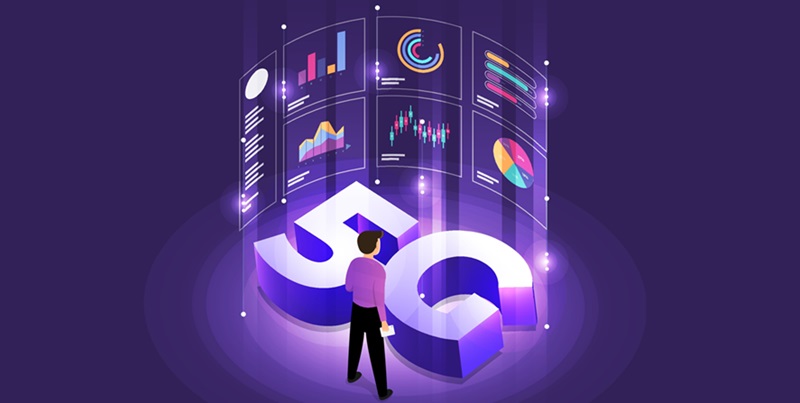As the world becomes increasingly connected, the integration of 5G and Internet of Things (IoT) technologies holds immense potential. This article explores the benefits of combining 5G with IoT devices, enabling faster data transmission, real-time communication, increased bandwidth, support for complex applications, low latency, enhanced reliability, improved battery life, efficient encrypted data transmission, and improved security for patient data in healthcare applications. The integration of 5G and IoT is set to revolutionize various industries and aspects of our lives.
Faster and More Efficient Data Transmission
Thanks to the lightning-fast speed of 5G networks, IoT devices can transmit data faster than ever before. With 5G, IoT devices can transfer large amounts of data swiftly and efficiently. This allows businesses and individuals to access and use critical information in real-time, revolutionizing the way we interact with technology. Whether it’s monitoring devices, collecting data, or controlling systems remotely, 5G enables IoT devices to transmit data at unprecedented speeds.
Real-Time Communication and Faster Decision-Making
One of the most significant advantages of integrating 5G with IoT is the ability of devices to communicate with each other in real time. This real-time communication enables faster decision making and response times. For instance, in smart grid systems, real-time communication between IoT devices and control centers facilitates efficient energy distribution and reduces power outages. Similarly, in industrial settings, real-time communication between sensors and machines allows for immediate adjustments, optimizing productivity and preventing costly downtime.
Increased Bandwidth for Larger Data Transmission
5G provides a substantial increase in bandwidth, allowing IoT devices to transmit and receive larger amounts of data. With this increased bandwidth, IoT applications can handle more data-intensive tasks. Autonomous vehicles, for instance, rely on massive amounts of data from numerous sensors. The higher bandwidth of 5G ensures seamless data transmission, enabling vehicles to make split-second decisions, enhancing safety, and enabling efficient transportation.
Enabling Complex IoT Applications
The combination of 5G and IoT paves the way for more advanced and complex applications. Smart cities, for instance, can utilize 5G’s high bandwidth and low latency to connect a vast array of sensors and devices throughout urban infrastructure. This connectivity allows for optimized traffic management, energy distribution, waste management, and real-time monitoring of environmental conditions. The integration of 5G and IoT enables cities to become more efficient, sustainable, and livable.
Low Latency for Seamless Communication
The low latency of 5G networks plays a crucial role in enabling seamless communication among IoT devices. When devices can communicate without delay, it opens up new possibilities for real-time applications. For example, in healthcare, the low latency of 5G allows for remote surgeries where surgeons can operate on patients in different locations. The reduced delay ensures precise control and eliminates any lag between the surgeon’s actions and the device’s response, ensuring patient safety and optimal outcomes.
Enhanced Reliability and Reduced Communication Errors
With 5G, IoT devices become more reliable, reducing the risk of communication errors. The low latency and high bandwidth of 5G networks improve the overall performance of IoT devices, minimizing data loss and transmission errors. This reliability is crucial in critical applications such as industrial automation or emergency response systems, where any communication failure can have severe consequences. By ensuring stable and reliable connections, 5G enhances the overall efficiency and effectiveness of IoT deployments across various sectors.
Improved Battery Life for Remote Devices
Battery life is a significant concern for IoT devices, particularly those operating in remote or hard-to-reach locations. 5G technology plays a vital role in conserving battery life, enabling devices to operate for longer periods without draining battery power. By reducing the amount of energy required for data transmission and optimizing network protocols, IoT devices can operate more efficiently, reducing the need for frequent battery replacement or recharging. This is particularly beneficial for applications like environmental monitoring or agricultural systems deployed in remote areas.
Efficient Encrypted Data Transmission
Enabling secure data transmission is essential in today’s interconnected world. 5G’s increased bandwidth capability allows for more efficient transmission of encrypted data, ensuring both privacy and security. Whether it’s transmitting sensitive financial information or personal data, 5G enables IoT applications to implement robust encryption algorithms without impacting performance. This seamless integration of security measures ensures the integrity and confidentiality of data in various industries, from finance to smart homes.
Security of Patient Data in Healthcare Applications
In healthcare, where data security and patient privacy are paramount, the integration of 5G and IoT plays a crucial role. 5G networks provide enhanced security protocols that protect patient data during transmission. With the ability to support high volumes of data traffic, 5G ensures secure and private communication between connected medical devices, healthcare professionals, and healthcare systems. This secure transmission of vital patient data enables remote monitoring, telemedicine, and faster response times, ultimately improving patient outcomes.
The integration of 5G and IoT is set to transform the world as we know it. With faster data transmission, real-time communication, increased bandwidth, low latency, enhanced reliability, improved battery life, efficient encryption, and improved security, the potential applications are limitless. From smart cities and autonomous vehicles to remote healthcare and industrial automation, the combination of 5G and IoT shapes a future where connectivity and innovation converge to create a more efficient, sustainable, and connected world.

